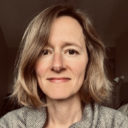This year we’ll hit Earth Overshoot Day, the day by which we’ve used up the ecological resources that the Earth could regenerate in one year, on 29 July, fully five months before the end of the year. This is utter madness: we have pushed the self-destruct button and piled our many possessions on top of it to hold it down. Richard Branson, Jeff Bezos and Elon Musk may be choosing to launch themselves into the void to escape the – well, possibility of creating another void here on Earth – but what can be done to push that day back to 31 December or beyond? What is the role for philanthropy in creating human systems that cultivate life, rather than destroying it?
I read Joanna Macy’s writings on the Great Turning some years ago, but recently the idea has sprung to mind more and more. As Macy describes it, the Turning is the process of shifting away from a ‘doomed economy of industrial growth to a life-sustaining society’. She sees three dimensions in terms of what needs to happen to facilitate that shift: holding actions (all the actions that slow down or hold back damage caused by the current systems, from public awareness-raising to direct action to legal campaigns); new structures and systems to replace the old ones (these are the ’emerging strands of a life-sustaining culture’, like community-based energy projects, social enterprises, the circular economy); and, finally, a shift in consciousness that leads to a sense of a connected self – no longer atomised individuals but people deeply connected to one another and to the rest of nature. The last dimension relates to our view of reality, the paradigm within which we function and operate. As is evident from Earth Overshoot Day, we currently – extraordinarily – operate within a paradigm that tells us not only that we can but that we should keep growing our economies based on the extraction of resources, even as the direness of the consequences becomes clear.
When it comes to philanthropy and these three dimensions of work – in particular environmental philanthropy, which is the area in which I work – where is the attention?
Holding actions are the bread and butter of environmental philanthropy, and indeed environmental work in general. Macy argues that they’re vital, and we can’t have the Great Turning without them – but nor are they enough. New structures and systems get some but rather less funding and attention – and again, are necessary but not enough. The third dimension, the shift in consciousness, requires a change in the story we tell ourselves of who we are: a shift to a story ‘that enhances our capacity and desire to act for our world’. I cannot say for sure how much funding goes into this space from environmental funders, but it’s probably safe to say ‘not much’. In many ways it seems mad to think of funding anything of the sort. At the same time, it seems just as mad to think we can get ourselves out of the mess we’re in with anything less than a profound shift in the consciousness that created it.
When my elder daughter was little and I was already in my job at the Environmental Funders Network, juggling work with her as well as twin toddlers and generally tearing my hair out, she said to me one morning on the way to school, “Mummy, I’ve decided that when I grow up I no longer want to be an astronaut. I want to be just like you and do nothing.”
It was hilariously depressing at the time (I think I cried with laughter, in that hysterical way of the sleep deprived), but now I am wondering if she might have been onto something. One thing a shift in consciousness might require of us is to do less, consume less, be less ‘productive’. What is the role of philanthropy in that shift? I’ve written here about environmental philanthropy, because that’s what I know – but this is clearly not just an issue for the ‘environmentalists’ among us.
When Jeff Bezos looked out at the abyss and then back at Earth – lush, dynamic, full of life – I wonder, did he reflect on the story of endless growth we tell ourselves? Untethered from the Earth and every need that it meets, what did he feel? I may never find out, but I know what he didn’t see: any other Earths for us to expand into as we overshoot our limits.
Florence Miller, CEO of the Environmental Funders Network





Comments (0)